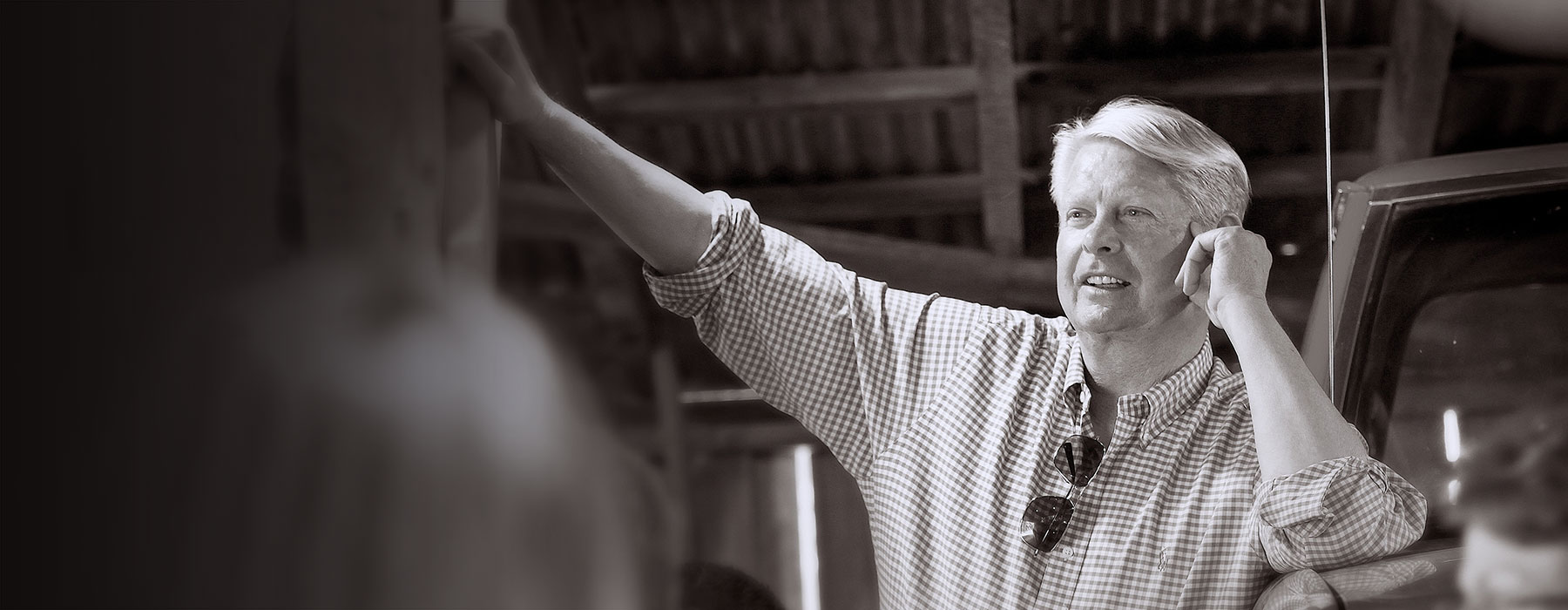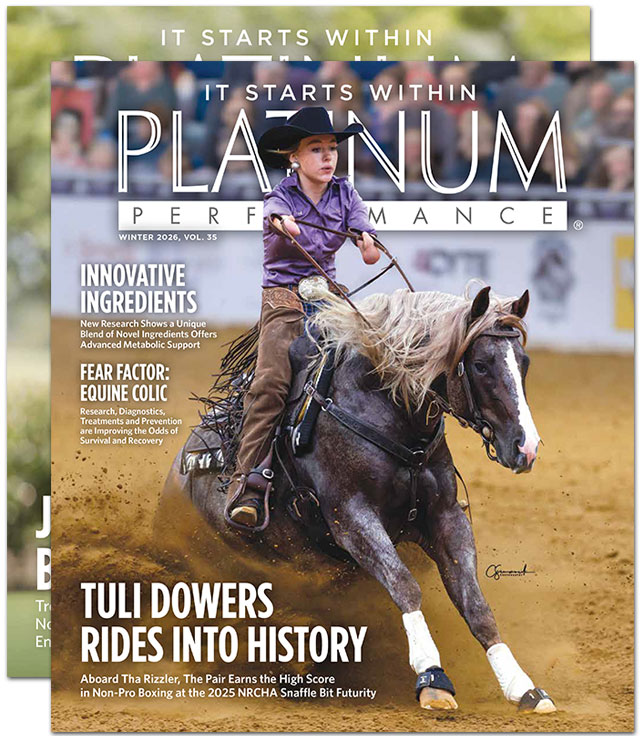A compassionate, humble person with an innovative mind, Dr. Doug Herthel significantly impacted veterinary medicine through industry-shifting contributions to colic surgery, fracture repair, stem cell therapy, the potential of Hyperbaric Oxygen Therapy & therapeutic nutrition.
Taken too early by Lewy Body Disease, Dr. Herthel lived a life of great purpose, deep connections and strong convictions. He will be greatly missed, never forgotten and celebrated in perpetuity for the life he lived.
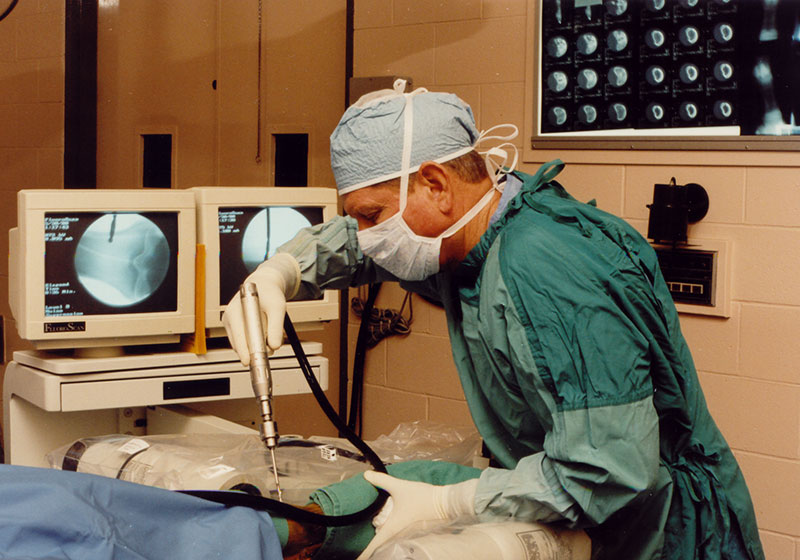
Dr. Doug Herthel performing surgery at Alamo Pintado Equine Medical Center.
Remembering the Extraordinary Life
& Celebrating the On-Going Legacy of
Dr. Doug Herthel
The Platinum Performance® family lost the brilliant and deeply passionate innovator that was Dr. Doug Herthel in July of 2018. He was a giant — not just to us but to the worldwide veterinary community he inspired, the tens of thousands of horses whose lives he saved or touched in some way, the clients whose fears he settled and the countless people who were impacted by his graciousness, tenacity and refusal to accept the status quo. He looked for a better way in everything he did. Dr. Herthel frequently changed the course of veterinary medicine, founded Alamo Pintado Equine Medical Center and revolutionized equine nutrition through Platinum Performance®. Above all, he taught us how to be better, serve better and challenge what is thought to be possible with the dream of conquering the impossible. He lived an extraordinary life that we are honored to have been a part of, and we'll proudly carry on the legacy at Platinum Performance® for many, many years to come.
“He wanted to make you better, and you wanted to be better because of him.”
— Mark Rick, DVM, Longtime Friend and Colleague of Dr. Herthel's at Alamo Pintado Equine Medical Center
A thinker and a problem solver, Dr. Herthel’s life’s work was inspired by his endless curiosity, pursuit of science and deep love of the horse. He was a man of great compassion, with a generous spirit and thoughtful approach to the way he practiced medicine and treated those around him. In Doug’s presence, new and old friends felt appreciated and valued, and he was interested and engaged in whomever crossed his path. He grew up in the, then rural, Hidden Hills area of California’s south coast and developed a love of horses at a young age with inspiration from his childhood veterinarian and mentor, Dr. Dave Simington. It was his first horse, a strapping sorrel gelding named Big Boy, that sealed Dr. Herthel’s fate and drove him further down the path that would define his career. He earned his veterinary degree from UC Davis, and it was during his time there that Doug was part of the team that conducted the first successful colic surgery, in 1968, helping to take the odds of survival in cases requiring surgical intervention from zero percent to above 90 percent today.
In 1972, Dr. Herthel completed veterinary school and moved to Los Olivos, California, as a newlywed with his wife, Sue, to build their veterinary practice. They were a team with a vision, practicing out of the back of their orange Chevy Vega. It was a leap of faith, with several months rolling by and no patients to work on. Eventually, their practice got started with their very first patient, a sheep in need of veterinary care. From there, the Herthels slowly built what is now known as Alamo Pintado Equine Medical Center, a world-renowned facility that has treated Kentucky Derby winners, Olympic-level athletes and horses of every class, breed and discipline. All were of equal value in the eyes of Dr. Herthel and his team.
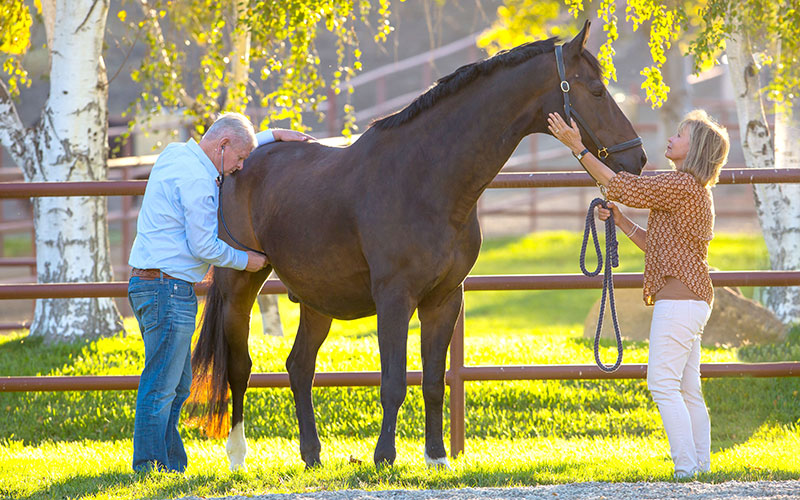
Dr. Doug Herthel and longtime client Cindy Riley with her horse Don.
PHOTO BY DREW STOECKLEIN
An Optimistic Outlook — Pushing the Boundaries of Medicine
It was Doug’s insistence from the beginning that the level of medicine practiced at Alamo Pintado would be exceptional, patients would be kept in a peaceful and comfortable environment and clients would experience a higher level of service. “Doug was just getting started with Alamo Pintado, and I remember thinking ‘this is just so far ahead of its time, will it work?’ ” says friend and client, Sandy Collier. “I should have known that it was his field of dreams per say, ‘if you build it they will come.’ He was just such a visionary and he was so far ahead of most of us.”
Dr. Herthel had a keen ability to look ahead toward techniques and treatments that would constantly push the limits of modern veterinary science. He approached challenges differently and always with a positive outlook, it was simply the way he was wired. When he recognized a disease or injury that was thought to be untreatable, he dove in with almost obsessive fervor. “No matter how much it looked like things weren’t going to work out, or you looked at a surgery and thought ‘there’s just no conceivable way that this could work,’ for some reason it worked, and he made it work,” says Dr. Ed Hamer, a longtime friend and veterinarian at Alamo Pintado. Dr. Carter Judy, friend and surgeon at Alamo Pintado echoes Dr. Hamer’s sentiments, “The thing that comes to mind is the word ‘yes.’ With Doug, the word ‘no’ was not in his vocabulary. Everything could be fixed, made better, improved on and every battle could be won.” Doug was a relentless pursuer of a better way to treat, heal and care for the horse. “If there seems to be a way and the horse is hanging in there, then don’t give up,” says Dr. Erin Byrne, Internal Medicine Specialist at Alamo Pintado. “He taught me that.”
President Ronald Reagan’s Veterinarian
John Barletta, a Secret Service Agent, was one of Dr. Herthel’s close friends and was also the head of President Ronald Reagan’s protection detail at the ‘Western White House’ — the President’s ranch in the hills above the Santa Ynez Valley. Through Barletta, Doug was introduced to the President and became his personal veterinarian.
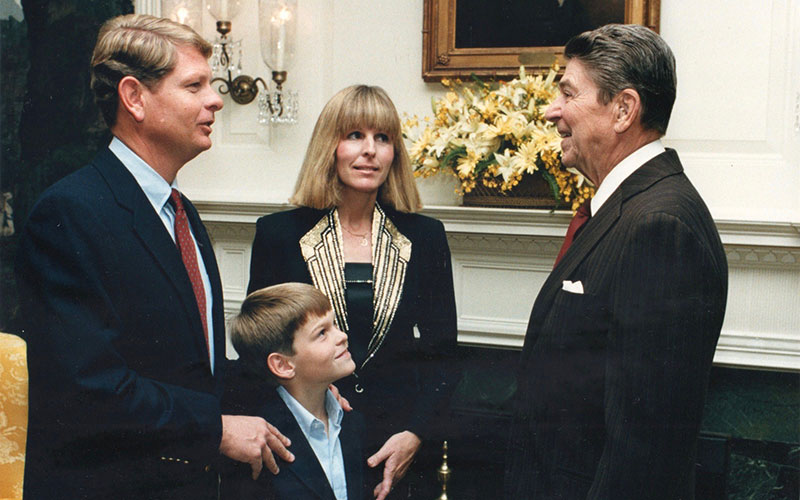
Dr. Doug Herthel, his wife Sue and son Mark with President Ronald Reagan at the White House. Dr. Herthel was the veterinarian to President Reagan's horses.
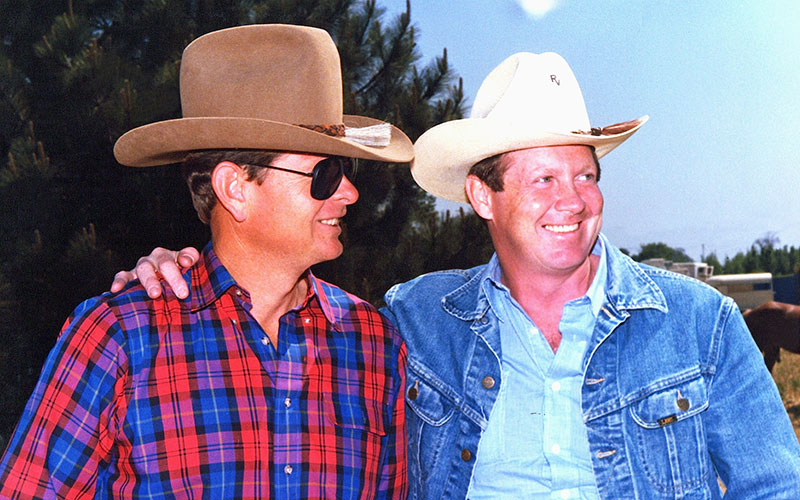
Dr. Doug Herthel, left, with his longtime friend John Barletta.
Impacting the Future of Veterinary Medicine
Dr. Herthel’s mark will forever be felt in veterinary medicine, but nudging him to talk openly about his achievements was near impossible. He was a humble man, always eager to give credit to the team he worked with and thought so highly of. A maverick in practice, Doug asked questions, challenged confines and threw himself wholly into a problem until he discovered a viable solution. Never afraid of a critique, he took big ideas and brought them to fruition with extreme dedication and perseverance. “I actually heard about Doug before I ever met him,” says friend and fellow equine surgeon, Dr. Wayne McIlwraith. “I arrived at the University of Guelph in 1974 to do a large animal internship, and my resident-mate was Dr. Jimmy Moore, Doug’s brother- in-law. We were there to learn to do specialized equine surgery, and those were the early days of colic surgery. Dr. Herthel was already doing it in the Santa Ynez Valley. He was one of the pioneers, he epitomized a lateral thinker. He generated concepts, ideas and treatments beyond the status quo.” Dr. Moore remembers those days well, “Doug was always larger than life to me,” he says fondly. “It’s now 50 years later, and he’s still larger than life.”
Beyond his contribution to colic surgery, Doug became the founding father of veterinary regenerative medicine, recognizing that the horse’s body, when given the right tools, can heal itself far better than any medical intervention. He worked tirelessly to develop this approach until its components were used as a mainstay in practices across the country. “In 2001 Doug presented a paper at the AAEP (American Association of Equine Practitioners) convention, where he put bone marrow into the suspensory ligament of 100 horses. It was the first instance of stem cells being put into the horse. That showed a lot of vision,” recalls Dr. McIlwraith. “He went on to culture stem cells in bio-reactors, which now allows us to greatly increase the number of cells. That was how he was able to try the use of stem cells intravenously and locally profused in laminitis. No one had ever done that before and he had success with that technique. It’s still a standard of treatment for those horses we’re trying to save with laminitis.” That day in 2001 inspired veterinarians to explore the reaches of regenerative medicine and start conversations that would lay the foundation for important advancements in treatment for both horses and humans. Doug showed how, previously, horses with torn suspensory ligaments had roughly a 20 percent chance of returning to work at the same level as they had been prior to injury. With the use of bone marrow-derived stem cells, up to 80 percent were able to return to their previous level of performance.
Dr. Herthel had a keen eye for recognizing areas in practice that were calling for improvement. In addition to his industry-shifting contributions to colic surgery and stem cell therapy, Dr. Herthel recognized the vast potential of hyperbaric oxygen therapy. “As co-owner of WinStar Farm, I was always on the lookout for new ways to better manage our horses,” says friend and client, Bill Casner. “One of the things that’s very close to my heart is hyperbaric oxygen therapy. Doug was the first veterinarian to really use it and to understand the power of it. He used it as a tool to accelerate healing in traumatic injuries, conquer tenacious infections like osteomyelitis and to elevate his colic surgery success. He would tell me ‘as soon as they come out of the recovery room, we put them in the chamber,’ ” remembers Casner. Dr. Herthel gave his best to every patient. He never stood still, was never deterred by a challenge and always looked for a better way.
A Nutritional Revolution
Dr. Herthel brought about a significant shift in veterinary medicine with his revolutionary work in regenerative therapies. The veterinary community saw a new capacity for healing that was previously thought to be unattainable. With stem cell therapy and hyperbaric oxygen therapy, there was renewed vigor and greater hope than ever before. Dr. Herthel had a larger vision, however. He was convinced that a third piece to the regenerative puzzle was missing in the way of therapeutic nutrition. He strongly believed in the therapeutic capabilities of nutrition and felt that with omega-3 fatty acids, antioxidants, amino acids, vitamins and trace minerals, he could improve both the speed and quality of healing in his equine patients. He dedicated endless hours to researching ingredients and committed to not just anecdotal results but to proven research.
“Doug was one of the first to recognize how important nutrition is to equine athletes and their ability to heal and perform at their optimum,” says Bill Casner. “And today Platinum Performance is the gold standard in veterinary therapeutic nutrition. It was a monumental effort, but Dr. Herthel committed from the start that the company would distribute only through themselves and equine veterinarians, feeling strongly that this level of nutrition belonged in a medical environment. “He worked on nutrition tirelessly,” remembers Troy Herthel. “He had text books all over the house when I was in middle school. A lot of times he’d even send some of the early test versions of Platinum with me to school in a sandwich bag. My friends always wondered what it was,” says Troy. It was the beginnings of what would become Platinum Performance®, and a novel approach to equine nutrition that would become a standard of care in subsequent years. “The running joke in the family is that I received Platinum as a child and my brother did not, hence the height discrepancy,” laughs the 6-foot, 6-inch Troy about his older and shorter brother, Mark.
Compassionate Care
Knowing Dr. Herthel, even for a short time, would be knowing his innate kindness and the depths of his compassion for his patients, clients and the people he came across in his daily life. “My dad changed veterinary medicine and saved the lives of thousands of horses," says eldest son, Mark Herthel. “He was innovative, selfless, brave and had an incredible work ethic. Most importantly though, he was compassionate and driven by love in all that he did.” Doug was the kind of person who inspired those around him, gaining some of his greatest fulfillment from mentoring the thousands of externs that have passed through Alamo Pintado and hundreds of first-year veterinarians that spent an entire year under the tutelage of Dr. Herthel and the Alamo team. “He wanted to make you better and you wanted to be better because of him,” says Dr. Mark Rick of Alamo Pintado, one of Dr. Herthel’s oldest friends and one of the first veterinarians to join Alamo Pintado. Bill Casner recalls a memory of Doug that struck him, “I was visiting Doug at the clinic when he showed me his new MRI. This was the first high field, ultra wide-bore MRI in private practice in the country. I asked, ‘how much did this thing cost’? Rude question, but I figured we were close enough friends at that point,” Casner says chuckling. “Doug laughed and said, ‘financially it won’t pay for itself, but it makes us better at what we do. Definitive diagnostics are the cornerstone of veterinary medicine, and this makes us better vets.’ That tells you what kind of man he was,” says Casner of his friend and veterinarian.
While Dr. Herthel founded Platinum Performance® with eldest son, Mark, it was his youngest son, Troy, who went on to pursue veterinary medicine and is now a boarded surgeon at Alamo Pintado Equine Medical Center. Troy had the opportunity to spend innumerable cherished hours in the operating room with his father, watching him work and crafting his own skills by absorbing the subtle nuances that made Doug such a gifted surgeon. Troy spent a lifetime witnessing his father’s compassion, but there was one instance that touched him deeply. “I had recently returned to Alamo Pintado after completing my veterinary internship in Weatherford, Texas. One night a middle-aged quarter horse arrived at the clinic in dire need of an emergency abdominal surgery. This type of surgery is a major undertaking and requires a significant degree of care — all of which can be quite expensive. The horse was owned by a young family, and the decision-making process was quite taxing. The owner was a ranch cowboy who was there with his young son who was about 8-years-old. It was obvious what this horse meant to this young boy as we stood there discussing the options with his dad. His dad decided that the financial impact that the surgery would have was not a viable option. You could see the hurt in both father and son’s eyes. My dad turned to me and said ‘we have to save this horse.’ He told the owner that we could take care of things for him. The surgery went well, and the horse went back home to the family. A couple of weeks later I walked upstairs to my dad’s office and found him with tears streaming down his face. I was scared at first. There was only a handful of times I had ever seen him cry. I asked what was wrong and he raised a handwritten letter he had received from the young boy. He started to read it to me with a trembling voice. The boy explained how thankful he was to everyone at Alamo for saving his horse, and how his horse was his best friend. He had broken his piggy bank to pay for the surgery but only came up with a few dollars. However, he did have one prized possession, a pocket knife that had been passed down to him from his family. My dad held the pocket knife in his hand, and we both started to cry.”
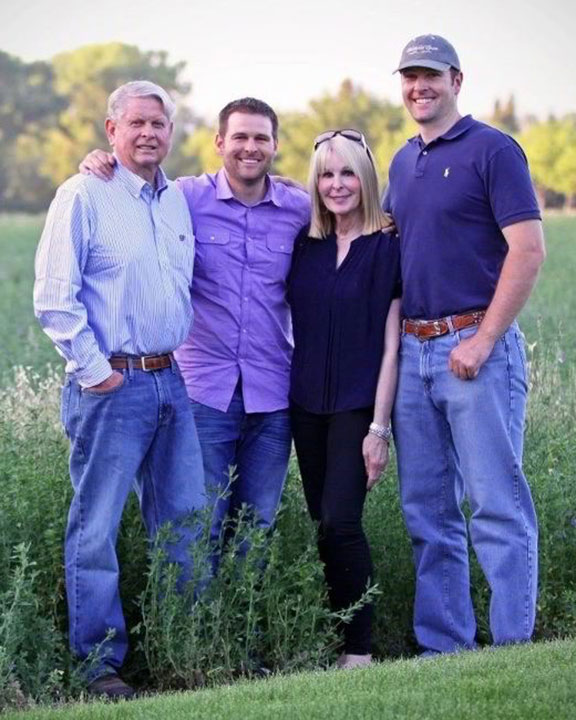
Dr. Doug Herthel's family.
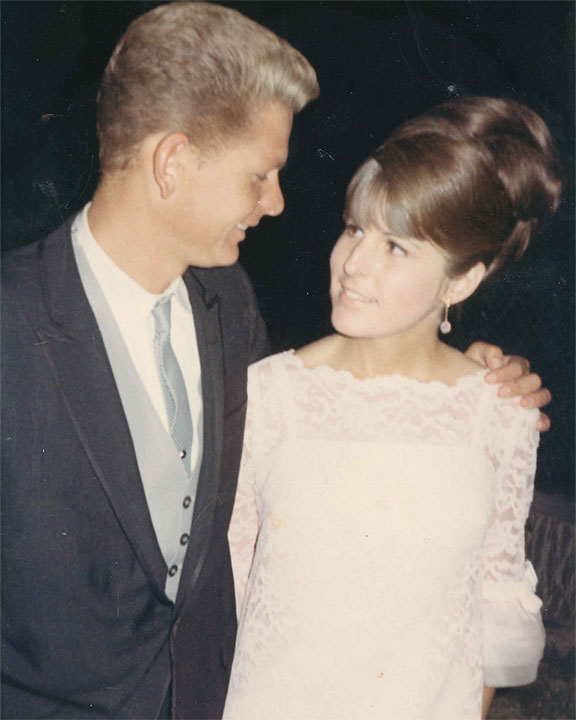
Dr. Herthel with wife Sue.
The Horse and Human Connection
While horses were a deeply held passion for Dr. Herthel, he was drawn to human medicine and how his work with horses could influence what was possible in their human counterparts. Through a fellow veterinarian, he met Mike Bottom, future coach of the USA Olympic Men’s Swim Team and trainer of twelve of the fastest men’s swimmers in the world at the time. One of his standouts was Gary Hall Jr. From a swimming dynasty, Gary was expected to carry the USA to numerous gold medals in the Olympic Games when, suddenly, he was diagnosed with Type I Diabetes at only 19-years-old. Doug immediately jumped in, and thanks to his nutritional counseling, the forward thinking of Coach Mike Bottom and the dedication of USC Endocrinologist, Dr. Ann Peters, Gary’s health and performance did an about-face, propelling him to several more gold medals and a long and extremely-successful career.
“There have been over 30 plus Olympic medals won by swimmers who learned how to train and recover with nutrition from my dad,” says Mark proudly. “He made a significant impact for these athletes and continues to.”
Along with colic surgery innovations and advancements in regenerative medicine, Dr. Herthel was known as a master of fracture repair. He appreciated the importance of collaborating with human physicians, namely orthopedic surgeons, to investigate whether what was happening in human orthopedics could be translated to equine patients. In fact, it could. From what he saw in human orthopedics, he was able to develop improved hardware for repairing equine fractures, improving outcomes for horses with formerly debilitating injuries.
Perhaps one of Dr. Herthel’s most significant innovations came in the form of a small package — Eli the donkey. Eli was sent to the clinic from a longtime client after suffering a catastrophic spinal cord injury after being bitten behind the neck and shook violently by a much larger Jack in the adjacent pen. The injury resembled that of a human after a devastating car accident and had left Eli a quadriplegic, unable to move any of his four limbs. Eli had an extremely poor prognosis, but his owner was committed to doing everything possible to save him. Dr. Herthel agreed to try, as long as the donkey could be kept comfortable. His idea was to inject millions of stem cells from a racehorse donor intravenously and also at the injury site. Within weeks Eli stood, and several months later, with round-the-clock care, therapy and stem cell injections, miraculously, Eli regained the use of his legs and walked, jogged and ran again. It was groundbreaking. Never before had paralysis been ‘cured’ in such a way. The equine and human medical communities took immediate notice, widely publishing articles detailing Eli’s story and investigating how the protocol used to treat Eli the donkey could one day treat human patients suffering from paralysis. The gravity of the outcome was game-changing.
“You know, when you go through life you meet a lot of people; some good, some bad and some ordinary. But once in a while you meet somebody special, somebody who has a quality to admire. For me, that was Doug.”
— Dr. Greg Ferraro, Close friend and classmate from UC Davis
A Life Well Lived
Dr. Doug Herthel lived a full and rich life. He experienced much, met people who fascinated him, loved deeply and gave so much of himself to his family, profession and his beloved Santa Ynez Valley. He drew great pride in watching his sons succeed in their own right and in their own areas of passion while giving him four grandchildren he adored beyond measure.
“You know, when you go through life you meet a lot of people; some good, some bad and some ordinary. But once in a while you meet somebody special, somebody who has a quality to admire. For me, that was Doug,” says close friend and classmate from UC Davis, Dr. Greg Ferraro. “He shared a lot of his time and knowledge, and I feel very grateful for that,” says Dr. Ali Daniel, a one-time intern at Alamo Pintado. “He’s come up with a lot of great ideas over the years, things that have changed what we do and drastically changed the course of veterinary medicine.”
Dr. Herthel lived a life of great purpose, deep connections and strong convictions. Doug cherished his family, was passionate about his work in veterinary medicine and cared greatly for the people and horses he touched. “There’s that often-used phrase — ‘there’s something about the outside of a horse that’s good for the inside of a man.’ And I always thought that it’s almost just the opposite with Doug. It’s what was inside of him that was so good for the horses,” says Dr. Rick, lovingly remembering the friend and colleague with whom he shared a small office for so many years above the hospital they worked so hard to form into what it is today.
“My dad personifies everything Alamo Pintado and Platinum Performance both stand for; the way they do business and how they treat patients, clients and each other,” says Mark. “A sterling example has been set for us over decades of watching him, and how he always challenged us to think bigger and never stand still. He believed so much in the people he worked with, and they’ll continue to carry on his legacy of innovation and compassion. They’ll make him proud.”
Dr. Doug Herthel will be fiercely missed, never forgotten and celebrated as the extraordinary man he was.
Doug Herthel, DVM, Memorial Research Fund
At Cleveland Clinic in Honor of Dr. Doug Herthel
To his family, Dr. Herthel’s greatest legacy will perhaps be that which happens after his passing. At the end of his life his brilliant mind was afflicted with Lewy Body Dementia, a progressive and aggressive form of dementia that is severely underdiagnosed and ravages the body and mind with no known cure. “After my dad’s illness, it has become a personal mission of ours to help connect the brightest minds in the human and equine medical communities in hopes that it may lead to advances in the diagnosis and treatment of Lewy Body Dementia — the disease that took him from us — as well as many other neurodegenerative conditions,” says Mark who, together with his mother Sue, brother Troy and their families, has established the Doug Herthel DVM Memorial Research Fund at Cleveland Clinic in honor of Dr. Herthel. The work being done there focused on Lewy Body Dementia shows great promise for significant breakthroughs, while the equine veterinary community sees potential for research regarding equine neurodegenerative conditions that may have human implications.
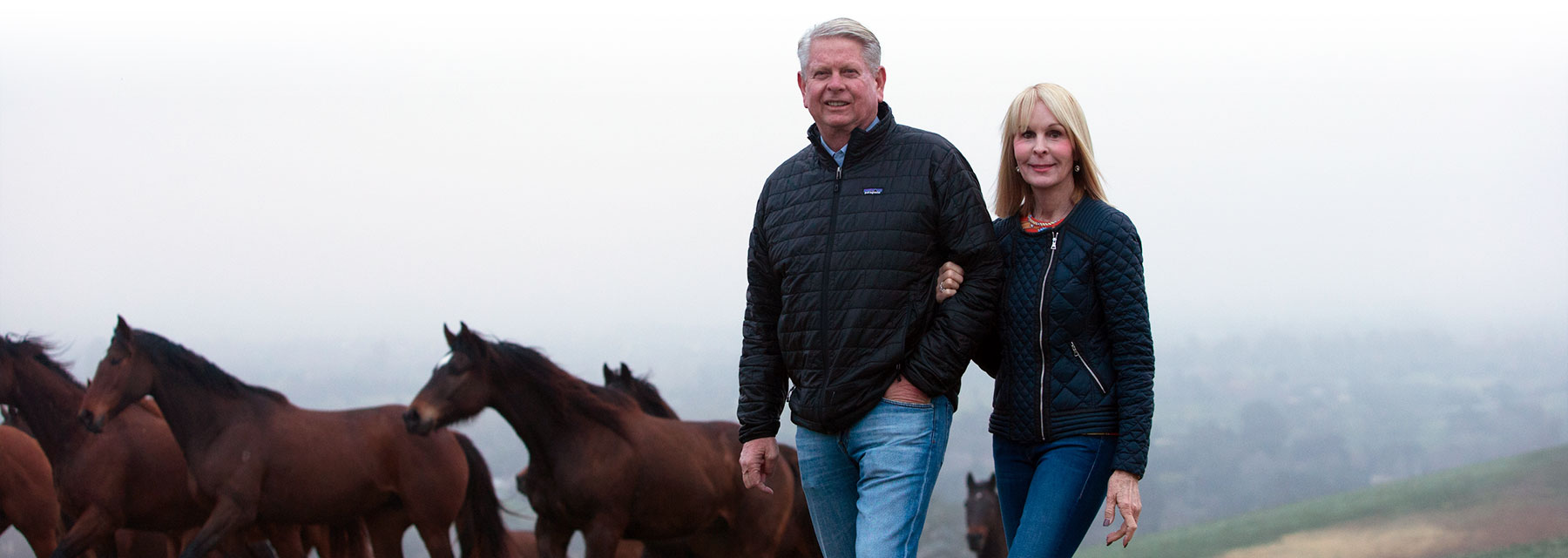

by Jessie Bengoa,
Platinum Performance®
